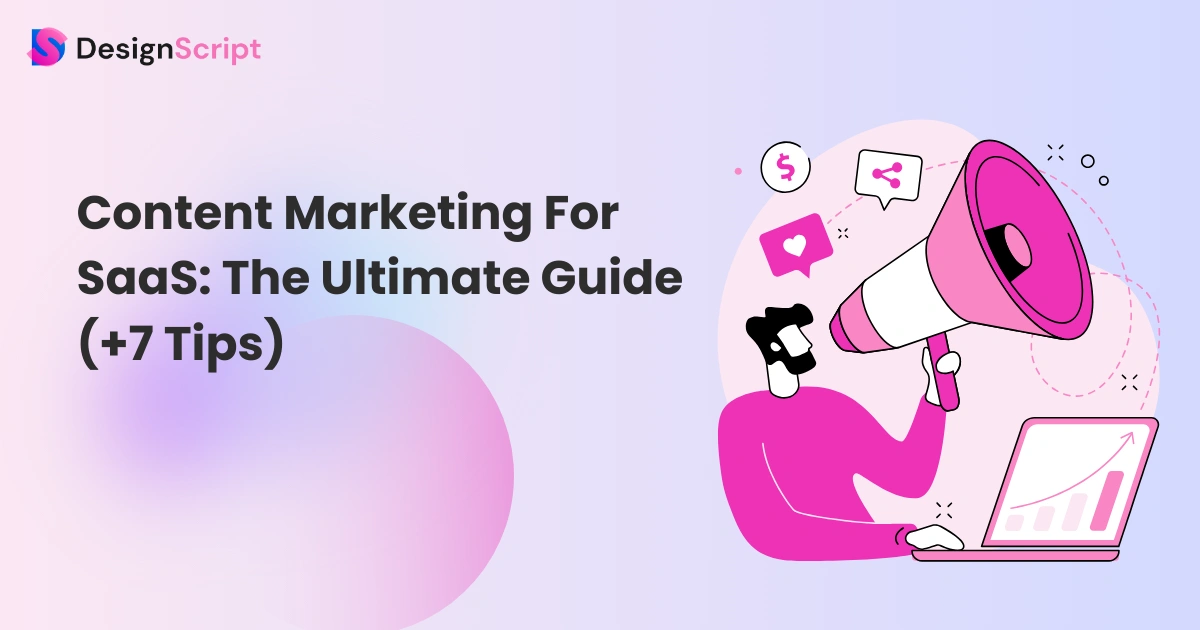Content Marketing For SaaS: The Ultimate Guide (+7 Tips)
The top 10% of SaaS blogs attracted an average of 45,700 views from organic search engines, according to CoBloom’s survey of 250 of the largest SaaS companies in the world. And most of the credit goes to the digital innovation of this era.
SaaS brands that blog can generate up to 67% more leads than those who don’t invest in content marketing. Plus, various types of content marketing, like brand content marketing, can increase client retention rates by 5% to 10%.
Hence, effective content marketing for SaaS companies is essential which is why you must try to focus on it. If you don’t know where to start, you have landed in the right place. We’ll help you build a strategy, provide effective tips and tools to help you achieve your goal.
So, without much ado, let’s begin!
Table of Content
- Why Is There A Different Approach For Content Marketing For SaaS Companies?
- B2B SaaS content marketing goals
- How To Build A B2B SaaS Content Strategy?
- Effective SaaS Content Marketing Tips
- Tools You Need To Build Your SaaS Content Marketing Strategy
- How To Generate Content Ideas?
- Elevate Your Content Marketing For Saas
- FAQs
Why Is There A Different Approach For Content Marketing For SaaS Companies?

There are several significant ways in which content marketing for SaaS is different from marketing in other industries.
The major differences in SaaS content marketing are the following:
- You market both services and technology.
- Search engine optimization is a priority in your marketing.
- Your marketing requires an educational approach.
- Reviews have a significant influence on your sales.
- You acknowledge customer risk.
- You include re-targeting in your content marketing strategy.
Since SaaS is a product, SaaS marketing could initially appear to focus on promoting a particular product. But this only tells half of the story. The quality of the assistance is a crucial consideration for SaaS clients when making provider selections. Why? It is because it indicates that SaaS marketing has a dual responsibility. First, to persuade clients to purchase the product. And second, the support that goes with it.
SaaS customers generally use digital channels for their product and service research. Given this, SEO becomes a crucial part of efficient SaaS marketing. SaaS customers frequently discover products via online tools. Like white papers, website reviews, and app stores. A key component of your marketing plan should include SEO content that draws customers from these sources.
B2B SaaS content marketing goals

4 goals make the foundation for B2B SaaS content marketing:
- Increasing brand awareness
- Educating clients
- Establishing credibility and trust
- Creating leads
Few people have mastered balancing a sound plan that generates growth and measurable outcomes when discussing B2B content marketing. This results in misleading value because some organizations continue to choose to disregard content as a crucial component of their marketing strategy.
However, by boosting brand awareness and positioning yourself as a brand thought leader over time, an excellent B2B SaaS content marketing plan might prove to be priceless. It’s vital to reinforce your market presence by providing viewers with practical, informed data.
Content marketing for SaaS aims at delivering relevant content to the relevant audience at the moment. Helping clients understand the product is one of the essential aspects of SaaS marketing. Marketers use a strategic approach specifically for content in content marketing. It includes all blog posts, emails, eBooks, landing pages, adverts, and more.
According to Mr. Seth Godin, you must be exceptional. Because finding your top new prospects depends on producing high-quality, purposeful content. Besides, showcasing your company’s skills and compelling content can help generate links and gain social media shares. It will also let you participate in discussions.
How To Build A B2B SaaS Content Strategy?

Building a tremendous B2B SaaS content strategy isn’t a piece of cake. But it’s also not rocket science. All it needs is planning and execution. Like Benjamin Franklin says: “If you fail to plan, you plan to fail.”
So, here is the right approach to get started with your content marketing for SaaS.
1. Define Your Business Goals
Optimization helps your content to reach new heights. But how can you get started with optimizing, though? By setting appropriate strategic goals. By strategic goal, we don’t mean a number or a measure. Instead, it should be pretty obvious what function content marketing will play within the framework and operations of your company. Different companies can have different goals. It depends on what they are seeking through their content marketing for SaaS.
Here are some concrete illustrations of strategic goals for your SaaS content marketing plan:
- Boost awareness of your brand among leads who are further along the sales pipeline than you previously targeted.
- Create a two-way dialogue with your audience. It promotes network effects and goodwill that will benefit your company.
- Create a list of contacts that includes information. It will help you determine which contacts are most likely to convert to customers.
- Develop a cumulative monthly lead flow for your sales team.
- Give automated sales pages and other automated acquisition tools a constant flow of leads.
- Promote consumer loyalty and brand advocacy.
2. Define Your Target Audience
Defining your target audience is equally important for content marketing for SaaS.
Research is necessary before writing relevant content for your audience. To understand the demands of your audience, you must look beyond simple keywords. Explore the questions like:
- What inquiries are being made in forums?
- What is the unspoken problem?
Move and find where your target audience is to get the answers to these questions! The most frequent mistakes in any particular SaaS strategy tend to lean in one of these directions:
- Concentrating on a small audience
- Concentrating on a large audience
Every audience needs perfect focus. However, it is virtually hard to place yourself on every platform actively. But you should know about all the platforms your consumers use. It will give you many chances to share content, give you a better idea of your audience’s interests, and help you find influencers.
3. Identify Pain Points
Building long-lasting relationships with customers are important. Moreover, taking the time to understand their journeys is also vital. It is one of the most acceptable methods to increase brand credibility. One quick question: How can you solve a customer’s issue if you don’t recognize their pain points?
Go above and beyond their expectations. But how? By using digital engagement technologies. For example, live chat, co-browsing, and AI chatbots. All these assist customers in real-time. Also, there are different ways to recognize customers’ pain points:
- Performing qualitative market research
- Find out your clients’ pain areas by listening to them.
4. Create A Content Lifecycle Strategy
Now you know the keywords you require to target. You also have definable objectives you want to meet. So, you can start creating keyword-focused content. Establish a detailed content lifecycle strategy to aid in content creation. The following actions are a part of creating content:
- Do some research on subjects related to your target market, the customer journey, and keywords
- Create a content marketing calendar
- Create and modify content
- Setting up your publishing schedule
Create and record standard operating procedures for each stage in this process. Use a project management tool to coordinate with your content creation staff to streamline your processes.
5. Finalize The Types Of Content To Create
You have a wide range of options for the kind of content you can produce. It can include written content like blog posts, ebooks, and audio content like podcasts. Determine which type and what platform will suit your marketing goals the best. It is also common to get confused when many options are available. And here research comes to your rescue. Keeping the points mentioned earlier in mind, and doing a bit more research on this aspect, will help you to make an informed decision.
Let’s also take an example in this case. If you are writing about a design-related topic, it might perform well on blogs, but it’ll do even better on podcasts. Designers are creative folks. So, they’ll get attracted to more interesting mediums rather than intellectual ones.
6. Conduct Competitor Analysis
Have you ever heard that evaluating yourself against others is not wise? That piece of advice is useless when we talk about e-commerce. Finding opportunities, addressing gaps, and making strategic advances depend on knowing where your company stands in the market compared to the competitors.
It is especially relevant in the context of content strategy. Your content competitors’ insights on what appeals to your target audience are rampant. And these revelations can either change the direction of your content or validate your existing route.
7. Perform Keyword Research
When it comes to content marketing for SaaS, we can’t just ignore the keyword research.
Your customers could use unique keywords to look for the information they require at every stage of their journey. For instance:
- Before learning about your business, consumers might look up tips on “how to” deal with a situation related to their pain points.
- After learning about your company, people might look for reviews.
- After customers start using your product, they might look online for instructions on finishing the setup.
- They might look for instructions on using particular aspects of your app as they actively use your product.
- When customers encounter customer service problems, they can look for remedies.
- They might look for renewal guidelines while thinking about renewing.
8. Create an Editorial Calendar
Designing an editorial calendar can create an outline for writing and posting content and ease the process. Plan and organize your content development process by using your audience research and a list of keyword goals. Create a variety of content for various media to draw in a larger audience. Examples include long-form, short-form, how-to guides, ebooks, photos, and videos. To be flexible in responding to recent developments in your market, avoid scheduling content too far in advance.
Establish a consistent, sustainable publishing schedule when planning your content. Calculate the quantity of content you produce each month to achieve your marketing objectives. Also, make a note of the amount of content you can manage to produce, given your budget and workforce.
9. Create Your Content
Since you’re done creating the content calendar, you can finally move on to create it. If you manage to be successful in the processes mentioned above, creating content shouldn’t take much time for you.
Set objectives for each piece of content you produce. For instance, growing brand recognition, generating leads, or educating your target market. To ensure that your content satisfies the market’s needs, draw on your research into the problems your audience faces. Remember that you are here to write for your audience, not to flex your language capabilities. Write what is concise, to the point, and transparent.
10. Finalize Distribution Strategy
Your distribution plan establishes the platforms and frequency at which you publish and advertise your content. Your plan should take into account things like:
- Where will you post your online website content? Will you list it in a resource part of your blog, website, or elsewhere?
- Will your content be open to the public, or will some have restrictions to paid subscribers only?
- What external websites would you leverage for content distribution through partnerships or guest blogging?
- Which social media platforms will you employ to promote and distribute content?
Utilize a marketing automation technology to post content to your website and social media accounts to save time on distribution.
11. Track Results and Make Adjustments
It’s crucial to keep track of the effectiveness of your campaigns. It ensures confidence in your marketing investment that it is producing the desired outcomes. You can achieve this by establishing a reporting system. It will monitor the key performance metrics you determined while setting the campaign’s objectives. For instance, include that KPI in your campaign outcome tracking if your objective is to boost sign-ups.
Use a dashboard-equipped analytics software package. This enables you to design customized displays and reports that track your preferred KPIs. Develop a routine evaluation process to evaluate the campaign’s results.
Effective SaaS Content Marketing Tips

If you need help developing your content marketing campaigns and don’t know where to start, these content marketing for SaaS tips are for you! If you follow these steps, it will become easier for you to optimize your SaaS content marketing. Moreover, you can grow your lead acquisition, conversion rates, and profits.
1. Divide your SaaS Content Marketing Efforts

Remember the concept of “Divide and Rule?” It’s not great to hear but great to apply in the case of SaaS content marketing. Many SaaS marketing folks do not devote the same amount of time to distribution as content production. Consider what would happen if you spent hours, days, or weeks crafting a fantastic piece, only to let it float aimlessly in the sea. It’s time to create a stir and get that piece in front of prospective buyers. Develop content that connects with the platform you’re using to share your piece, and take your distribution plan a step further.
2. Try your best to get a backlink

Backlinks add the vital foundation to raise your search engine rankings. The number one search ranking criteria for Google is your backlink profile. Your possibility of ranking higher increases with the number of high-quality backlinks you may get for your website. The value of backlinks to SEO (search engine optimization) is also enormous. They give your website and its content a seal of approval.
3. Build hype

Make sure that customers have a complete content marketing journey (it will help you with content marketing for SaaS in the long run). In an introduction, you cannot simultaneously drag your feet and save the best stuff for the final, striking moment. Start strong and hold people’s interest throughout the entire piece. Hold your peak!
Most companies believe attracting customers is as simple as providing a compelling beginning to any content. Well, not really! Plan your content according to that. It should get more compelling when it reaches the CTA.
When a potential customer gets to the CTA, you will have converted them from an uninterested guest into a hyped-up, assured lead. Furthermore, you will increase lead conversion while lowering the bounce rate.
4. Create content for a problem, not a solution

We reach larger audiences and remain relevant to potential customers when we concentrate on the issue to create a content marketing strategy. Content marketing for Saas is more about building funnels to get there, not creating landing pages. For each piece of content, specify a goal, the metrics to assess that goal, and write to solve challenges that contribute to that goal.
Your readers will be more interested in reading content that solves their problems. And not something on a pre-existing solution.
5. Write for each stage of the funnel

Writing according to the marketing funnels is the right approach for SaaS content marketing. Awareness, assessment, purchase, and delight are the four phases of the content marketing funnel. Every stage should have a specific function in the buyer’s journey, and the content at each stage should reflect this. Make sure you put the right content in the TOFU, MOFU, and BOFU. Use TOFU content to draw in your target audience, BOFU content to align your brand, and push a distinctive POV inside the market. All three stages are equally important and require curated content to serve their specific purpose.
6. Insert GIFs & Memes

One thing that memes and GIFs reflect the most is originality. Memes and GIFs work to motivate people. Their goal is to communicate a message that appeals to readers’ interests. So, it’s safe to say that people make these types of content with the general public in mind. They are widely utilized, accessible, and plentiful. Memes and GIFs highlight the ingenuity that has contributed to the internet’s success. Your content marketing for SaaS may lack a personal touch. But you can fix it with these types of add-ons as it increases user engagement. Want to know the best thing about memes and GIFs? They can be addictive.
7. Add Short Video Demos and Tutorials

It is hard to appeal to consumers’ emotions. Fancy knowing why? It is due to the rational explanations behind why people make purchasing decisions based on emotion. Short video demos and tutorials are the best ways to educate your audience interactively. There are many other ways to create a short-form video such as live streams, snaps, sizzles, teasers, sponsored content, etc. The length of the average person’s attention span is decreasing thanks to social media having taken over the world with its visual experiences. Short-form videos provide more flexibility in developing accurate, relatable, and to-the-point videos. These videos can lessen the burden of producing more in-depth content.
Tools You Need To Build Your SaaS Content Marketing Strategy

1. HubSpot
HubSpot is a comprehensive inbound marketing, sales, and CRM platform. It offers content marketers all the resources they need to produce actionable content that generates leads and revenues. The marketing suite of HubSpot comes loaded with the necessary tools you need to produce and optimize your content. It also makes sure that the right audience sees your content. Additionally, HubSpot evaluates your marketing plan in terms of sales and general performance.
2. Contentools
Contentools is an effective content marketing platform. It allows users to create, publish, and analyze content for marketing campaigns. With the help of an in-built content editor, you can quickly write SEO-friendly content. A few noteworthy features are:
- It’s AI-powered content analysis.
- Automatic social media post publishing.
- Collaboration support.
You can also integrate it with a ton of third-party apps like Salesforce, Evernote, Dropbox, and more.
3. WordPress
WordPress will be your best decision if you want to create hassle-free excellent blog content. It gives marketers the resources to set up a website or blog. Additionally, you get a user-friendly publishing platform. It works for creating and uploading content, tracking visitors, and accessing various plugins. All these features help you optimize your SaaS content marketing strategy.
4. Google
We can hardly leave Google while talking about content marketing tools. Tools like Keyword Planner, Google Analytics, Google Search Console, Google Trends, etc., certainly change your content marketing game. All these tools help in conducting research and provide a detailed overview of your content performance in no time. Most importantly, Google lets you access all these tools for free.
How To Generate Content Ideas?

Writing what counts is hard. But getting ideas on what to write is even more challenging. And to be honest, writer’s block is common in this case. Yet, there is a way to source new ideas without much effort. You need to create a system with strategies, and you’ll have your ideas fresh on the plate. Here’s how you can do it:
Ask Your Audience on Social Media or in the Email
The most powerful and easiest way is leveraging social media. More than 4.26 billion people use it today. And they all love to share and comment, even when nobody asks them. Imagine what would happen if you’ll genuinely ask them! Facebook, Instagram, and Quora are the best platforms in this case.
Communicating with this online audience via social media or email can give you insights. These insights will be about their interests, trends, or something that will give you a boost. It makes getting ideas about content, products, or services more accessible. You may find some of these leading nowhere. But others might be beneficial for your brainstorming process.
Ask Your Sales Team and Customer Success Team
Thoughtful answers come from asking intelligent questions. Your sales and customer success team are professional people that you hired. They are here because they have the skills and experience. Make sure that this skill and experience count. They certainly know what’s going on in the company and out there and using them to get content ideas is a fair game. The following list of five savvy questions can help you learn more about your staff, your company, and the hostile marketplace:
1. What presents the most significant challenge in attracting new clients?
2. What is and isn’t working?
3. What opportunities do you see as most (and least) important?
4. If you could solve one issue with a magic wand, what would it be?
5. Who are your most potent competitors, and how are they doing well?
Utilize Your Unique Data
Every brand or marketer conducts their research to have unique data initially. But afterward, they pay no attention to it and focus on new advanced and new marketing methods. It is a mistake, though. Analyzing data can give you many ideas for your SaaS content marketing strategy. For instance, do you know what’s trending in your industry? If not, then search up. If yes, write about that!
You can also develop content ideas using a few SEO tools and strategies. Google Search Console is a resource to use. You should be able to see the Google queries visitors used to locate your website.
Run a Series of Interviews
It will work like social media only. But will give you a better understanding of your audience’s perspective. How can you get better answers than asking them directly what they want to read?
That’s why running a series of interviews and asking them about their habits, hobbies, and more can be beneficial. An interview has the advantage of not having to be blunt.
Just find methods that encourage conversation casually.
Some of these ideas can be rather interesting and could surprise you. People will start supplying you with fresh article ideas without realizing it.
Recording your interviews is even better. Instead of hurriedly attempting to jot down notes as someone is speaking, you can review them later.
Repurpose Existing Content
Don’t let your previous content get lost in time. Use those subjects as inspiration. Changing titles and creating a new post from a different perspective can help.
Let’s take the case where your business is in the marketing of mobile apps. A new topic might be how to increase your ranking to obtain more downloads if you had previously produced an article about how to get ratings on the app store.
The subjects are somewhat related but not nearly the same.
Or suppose you work in the field of fitness. And you previously wrote about “How To Gain A Healthy Weight.” Now, you could use some of the information in that post to create a new article on “Best Weight Gaining Foods”
Attend Webinars
Webinars are the best approach to generating high-quality leads, according to 73% of B2B marketers. Webinars generally cover engaging topics. These topics revolve around case studies, research, blogs, and new events.
These topics ensure audience retention. Watching sales webinars of successful brands and individuals is a starting point. And analyzing how the audience is reacting to it is the next step. Try to carefully watch what questions these people ask. It will let you know what they are thinking. And you’ll have your next set of fresh content ideas.
Elevate Your Content Marketing For Saas

Content marketing offers more value to brands than traditional forms of marketing. The significant difference is that content marketing costs 62% less than conventional marketing. Moreover, it produces three times as many leads. If that isn’t crazy for you, we don’t know what will be!
Drawing out a conclusion from this, all we can say is that content marketing for SaaS companies is equally important and worth investing in. One such strategy would have your business counting revenue and ticking off most of your goals. Following the mindful tips, tools, and ideas for SaaS content marketing, you can be an expert in your field.
FAQs
SaaS firms’ significant content marketing goals are driving brand awareness and generating leads and conversions. Because it brings attention to your brand, content marketing for Saas may be a terrific PR tool.
Your SaaS content needs to be helpful, relevant, and persuasive. It should address your audience’s problems and demonstrate how your product functions. Strong CTAs are also a part of SaaS content.
A successful SaaS content marketing plan will educate your target market about your product’s benefits and usefulness. It is more convenient, straightforward, and cost-effective than conventional marketing methods.

